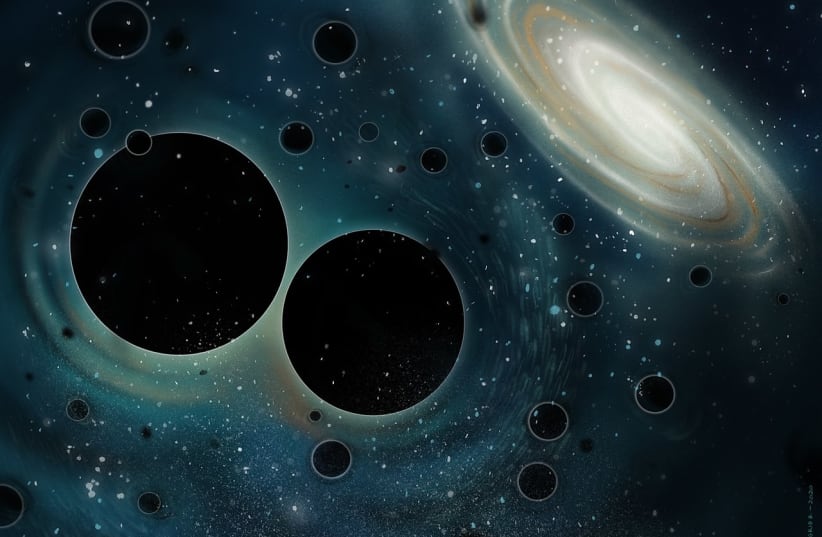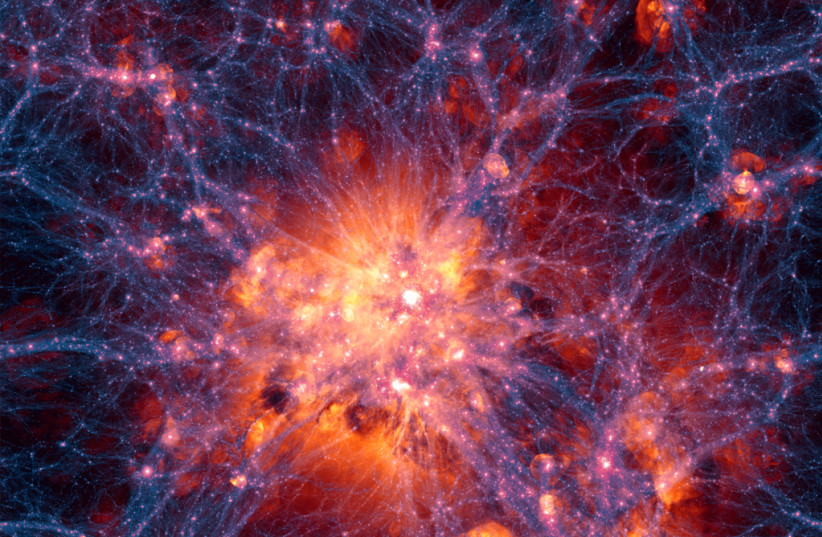Scientists explain missing black holes, dark matter with new model - study
Japanese researchers have proposed a new model for the formation of primordial black holes that could help explain the mysteries of dark matter and the early universe.
Japanese scientists have put together a new model to explain some of the universe's biggest mysteries: Missing black holes and the possible existence of dark matter.
The findings of this study were published in the peer-reviewed academic journal Physical Review Letters.
If true, the results of this research will help paint a more thorough picture of the early universe and the fabric of the cosmos itself.
Cosmic conundrums: Black holes, dark matter, and the birth of the universe
This study deals with some very complicated and still not fully understood concepts in astrophysics, so let's break it down one at a time.
First, let's start with the simplest: The universe itself.
Dark matter and gas (Illustrative). (credit: Wikimedia Commons)
The universe is thought to be around 13.8 billion years old. While starting incredibly small, it has since exploded into the nigh-infinite reaches of space we all know today. Since the Big Bang, the universe has gone from this small singularity to a paradoxically bustling yet empty span of space, populated by stars, galaxies, and other structures while also having vast amounts of emptiness.
But cosmic microwave background radiation (CMB) is also present in the universe. This is essentially the leftovers of the Big Bang itself, and it can be found everywhere.
Now, let's talk about dark matter.
To put it simply, we don't know what dark matter is. We think dark matter is the impossible-to-see matter that exists throughout the universe, which makes the collective mass of everything in the universe much heavier than it seems.
In theory, dark matter is an invisible substance emitting no light that makes up over 85% of matter in the observable universe. The standard model of cosmology also stipulates that it is vital to the universe's continued evolution
We only know it exists – supposedly, as some researchers still debate its existence – due to gravity. Gravity as we know it is explained by Albert Einstein's Theory of General Relativity. Anything that can't be explained by it is usually thought to be due to the influence of dark matter.
However, some researchers have suggested a different possible explanation for dark matter, and that's our next topic: black holes.
Black holes are massive concentrations of gravity so strong that nothing, not even light, can escape, making them invisible. Like dark matter, the only way scientists were able to tell they existed was through gravity, and like dark matter, they play a key role in the function of the universe.
However, unlike dark matter, which is so mysterious that some scientists question whether it even exists, black holes are a very well-established scientific fact. Most of them form when a large star dies, which plays a major role in the life cycles of stars and galaxies.
But research has also suggested that black holes may not just form when stars die. Rather, they may have existed since the start of the universe.
These hypothetical black holes from the dawn of the universe are known as primordial black holes (PBHs), and they would predate the birth of stars.
But aside from solving many other mysteries, such as the James Webb Space Telescope's discoveries of massive galaxies in the early universe that shouldn't have been able to form at that time, scientists also think they could solve another mystery: dark matter.
Black holes are incredibly dense and heavy, so they could, in theory, help explain the extra mass in the universe attributed to dark matter. In addition, they could help explain other mysteries. But all of this hinges on one thing: There must be enough of them in the universe. And so far, scientists haven't been able to find them.
"Since the recent innovation of gravitational wave astronomy, there have been discoveries of binary black hole mergers, which can be explained if PBHs exist in large numbers," graduate student Jason Kristiano said. "But despite these strong reasons for their expected abundance, we have not seen any directly, and now we have a model that should explain why this is the case."
The research on the formation of primordial black holes has issues with the researchers behind the study. For instance, the CMB doesn't seem to support the leading proponents of how these black holes would have formed.
So, when faced with a model that seemed to conflict with the established CMB data, the researchers did the only thing they could: They fixed the model to ensure it aligned with the data.
"At the beginning, the universe was incredibly small, much smaller than the size of a single atom. Cosmic inflation rapidly expanded that by 25 orders of magnitude. At that time, waves traveling through this tiny space could have had relatively large amplitudes but very short wavelengths. What we have found is that these tiny but strong waves can translate to otherwise inexplicable amplification of much longer waves we see in the present CMB," said Prof. Jun'ichi Yokoyama, director of the Research Center for the Early Universe (RESCEU) and Kavli Institute for the Physics and Mathematics of the Universe (Kavli IPMU, WPI) at the University of Tokyo.
"We believe this is due to occasional instances of coherence between these early short waves, which can be explained using quantum field theory, the most robust theory we have to describe everyday phenomena such as photons or electrons. While individual short waves would be relatively powerless, coherent groups would have the power to reshape waves much larger than themselves. This is a rare instance of where a theory of something at one extreme scale seems to explain something at the opposite end of the scale."
So, we're dealing with wavelengths and fluctuations. The idea is rather complex, but to put it simply, small-scale fluctuations in the early universe actually impact the larger fluctuations in the CMB. This is a big deal, but it matters because it gives new implications for anything that relies on these kinds of wavelengths.
And it is precisely these short-yet-strong wavelengths that are thought to create primordial black holes.
Overall, primordial black holes should still exist. But based on this new model, there wouldn't need to be as many of them as previously believed.
But all of this is still theoretical. What's needed is some actual research to back it up. Luckily, a joint observation mission between the US, Italy, and Japan is doing just that: studying what are likely primordial black holes.
The results of this study will determine just how accurate this model is.
THIS PAGE WAS POSTED BY SPUTNIK ONE OF THE SPUTNIKS ORBIT BLOG
HTTPS://DISQUS.COM/HOME/FORUM/THESPUTNIKSORBIT-BLOGSPOT-COM/
























